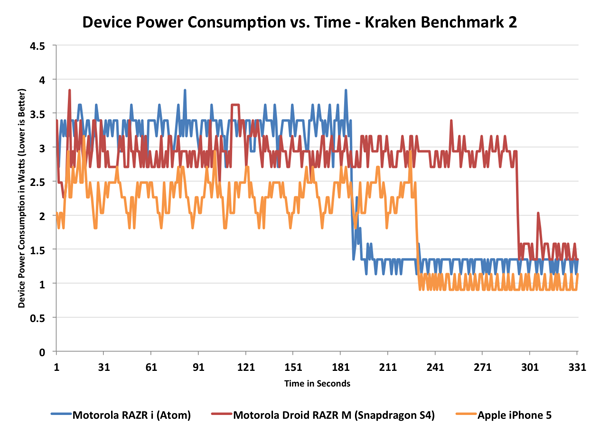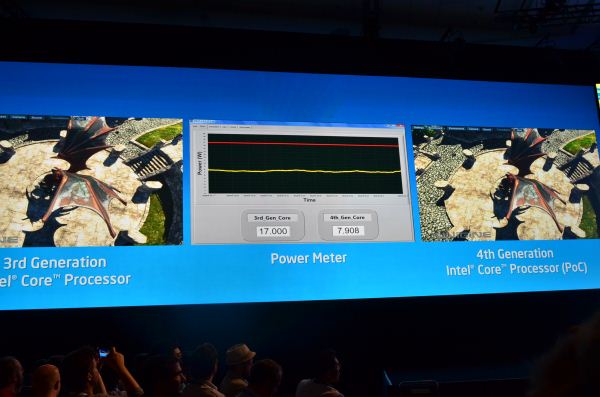The ARM vs x86 Wars Have Begun: In-Depth Power Analysis of Atom, Krait & Cortex A15
by Anand Lal Shimpi on January 4, 2013 7:32 AM EST- Posted in
- Tablets
- Intel
- Samsung
- Arm
- Cortex A15
- Smartphones
- Mobile
- SoCs
Final Words
Whereas I didn't really have anything new to conclude in the original article (Atom Z2760 is faster and more power efficient than Tegra 3), there's a lot to talk about here. We already know that Atom is faster than Krait, but from a power standpoint the two SoCs are extremely competitive. At the platform level Intel (at least in the Acer W510) generally leads in power efficiency. Note that this advantage could just as easily be due to display and other power advantages in the W510 itself and not necessarily indicative of an SoC advantage.
Looking at the CPU cores themselves, Qualcomm takes the lead. It's unclear how things would change if we could include L2 cache power consumption for Qualcomm as we do for Intel (see page 2 for an explanation). I suspect that Qualcomm does maintain the power advantage here though, even with the L2 cache included.
On the GPU side, Intel/Imagination win there although the roles reverse as Adreno 225 holds a performance advantage. For modern UI performance, the PowerVR SGX 545 is good enough but Adreno 225 is clearly the faster 3D GPU. Intel has underspecced its ultra mobile GPUs for a while, so a lot of the power advantage is due to the lower performing GPU. In 2D/modern UI tests however, the performance advantage isn't realized and thus the power advantage is still valid.
Qualcomm is able to generally push to lower idle power levels, indicating that even Intel's 32nm SoC process is getting a little long in the tooth. TSMC's 28nm LP and Samsung's 32nm LP processes both help silicon built in those fabs drive down to insanely low idle power levels. That being said, it is still surprising to me that a 5-year-old Atom architecture paired with a low power version of a 3-year-old process technology can be this competitive. In the next 9 - 12 months we'll finally get an updated, out-of-order Atom core built on a brand new 22nm low power/SoC process from Intel. This is one area where we should see real improvement. Intel's chances to do well in this space are good if it can manage to execute well and get its parts into designs people care about.

Device level power consumption, from our iPhone 5 review, look familiar?
If the previous article was about busting the x86 power myth, one key takeaway here is that Intel's low power SoC designs are headed in the right direction. Atom's power curve looks a lot like Qualcomm's, and I suspect a lot like Apple's. There are performance/power tradeoffs that all three make, but they're all being designed the way they should.
The Cortex A15 data is honestly the most intriguing. I'm not sure how the first A15 based smartphone SoCs will compare to Exynos 5 Dual in terms of power consumption, but at least based on the data here it looks like Cortex A15 is really in a league of its own when it comes to power consumption. Depending on the task that may not be an issue, but you still need a chassis that's capable of dissipating 1 - 4x the power of a present day smartphone SoC made by Qualcomm or Intel. Obviously for tablets the Cortex A15 can work just fine, but I am curious to see what will happen in a smartphone form factor. With lower voltage/clocks and a well architected turbo mode it may be possible to deliver reasonable battery life, but simply tossing the Exynos 5 Dual from the Nexus 10 into a smartphone isn't going to work well. It's very obvious to me why ARM proposed big.LITTLE with Cortex A15 and why Apple designed Swift.
I'd always heard about Haswell as the solution to the ARM problem, particularly in reference to the Cortex A15. The data here, particularly on the previous page, helped me understand exactly what that meant. Under a CPU or GPU heavy workload, the Exynos 5 Dual will draw around 4W. Peak TDP however is closer to 8W. If you remember back to IDF, Intel specifically called out 8W as a potential design target for Haswell. In reality, I expect that we'll see Haswell parts even lower power than that. While it may still be a stretch to bring Haswell down to 4W, it's very clear to me that Intel sees this as a possiblity in the near term. Perhaps not at 22nm, but definitely at 14nm. We already know Core can hit below 8W at 22nm, if it can get down to around 4W then that opens up a whole new class of form factors to a traditionally high-end architecture.
Ultimately I feel like that's how all of this is going to play out. Intel's Core architectures will likely service the 4W and above space, while Atom will take care of everything else below it. The really crazy part is that it's not too absurd to think about being able to get a Core based SoC into a large smartphone as early as 14nm, and definitely by 10nm (~2017) should the need arise. We've often talked about smartphones being used as mainstream computing devices in the future, but this is how we're going to get there. By the time Intel moves to 10nm ultramobile SoCs, you'll be able to get somewhere around Sandy/Ivy Bridge class performance in a phone.
At the end of the day, I'd say that Intel's chances for long term success in the tablet space are pretty good - at least architecturally. Intel still needs a Nexus, iPad or other similarly important design win, but it should have the right technology to get there by 2014. It's up to Paul or his replacement to ensure that everything works on the business side.
As far as smartphones go, the problem is a lot more complicated. Intel needs a good high-end baseband strategy which, as of late, the Infineon acquisition hasn't been able to produce. I've heard promising things in this regard but the baseband side of Intel remains embarassingly quiet. This is an area where Qualcomm is really the undisputed leader, Intel has a lot of work ahead of it here. As for the rest of the smartphone SoC, Intel is on the right track. Its existing architecture remains performance and power competitive with the best Qualcomm has to offer today. Both Intel and Qualcomm have architecture updates planned in the not too distant future (with Qualcomm out of the gate first), so this will be one interesting battle to watch. If ARM is the new AMD, then Krait is the new Athlon 64. The difference is, this time, Intel isn't shipping a Pentium 4.











140 Comments
View All Comments
extide - Friday, January 4, 2013 - link
When will you post an article about Bay Trail / Valley View?? Usually you guys are pretty fast to post stuff about topics like this yet I have seen some info on other sites already...jpcy - Friday, January 4, 2013 - link
...which I bet CISC users thought had ended about 18 years ago...It's good to see a resurgence of this highly useful, extremely low-power and very hardy British CPU platform.
I remember back in the day when ARMs were used in the Acorn computers (possibly too long ago for most to remember, now - I still have an A7000 and a RISC PC with both a StrongARM and a DX2-66 lol) was at war with Intel's Pentium CPU range and AMD's K6's, boasting an almost 1:1 ration of MIPS:MHz - Horsepower for your money (something Intel and AMD were severely lacking in, if I remember correctly.)
And now, well, who'dve thought it... These ARM CPUs are now in nearly everything we use... Phones, smartphones, tablets, notebooks...
Suppose I was right in the argument with my mate in school afterall... RISC, superior technology (IMHO) may well take over, yet!
nofumble62 - Friday, January 4, 2013 - link
No performance advantage, no battery life advantage. Why anyone would bother with incompatible software?sseemaku - Friday, January 4, 2013 - link
Looks like people have changed religion from AMD to ARM. Thats what I see from some comments.mugiebahar - Saturday, January 5, 2013 - link
Yeah n no. They wanted a no paid opinions to screw with the outcome. But Intel hype won over real life .Intel better and will get better - yes
Any chance they will compete (performance and PRICE) and legacy. Support to phone apps - Never in the near future which is the only time for them.
tuxRoller - Saturday, January 5, 2013 - link
Also, any chance for an actual performance comparison between the platforms?Apple's performance and power use look awesome. Better than I had imagined.
I'd love to see how they compare on the same tests, however.
Kogies - Saturday, January 5, 2013 - link
It appears the war has begun, well two wars in fact. The one you have articulately described, and the oft ensuing war-of-words...Thanks Anand, I appreciate the analysis you have given. It is excellent to get to see the level of granularity you have been able to achieve with your balance of art and science, and knowing where to hook into! I am very interested to see how the L2 cache power draw effects the comparison, just a little jitter in my mind. If nothing else, it looks as if the delicate balance of process tech., and desired performance/power may have a greater bearing on this "war" than mere ISA.
With Krait 300, Haswell, and more A15's this is going to be a tremendous year. Keep up the good work.
Torrijos - Saturday, January 5, 2013 - link
Any chance we could see the same tests run on the latest Apple iPad?That way we could have a chance to see what Apple tried to improve compared to the A15 generation.
urielshun - Saturday, January 5, 2013 - link
The whole discussion about ARM and x86 is not important when you go for the ecomonics of each platform. ARM is dirty cheap and works well. It's 1/10th of the price of any current Atom with decent perfomace (talking about RK3066).Don't underestimate the Chinese they are having a field day with ARM's pricing model and and have shown amazing chips.
In 8 years from now all SoC's would have reached the usuable performace and the only thing that will matter will be power and cost of integration.
iwod - Saturday, January 5, 2013 - link
Where are you getting 1/10 of a price from? Unless they are produced on good old 40nm LP Node with Nothing else, or crap included, otherwise there just aren't any Chinese SoC selling for $4